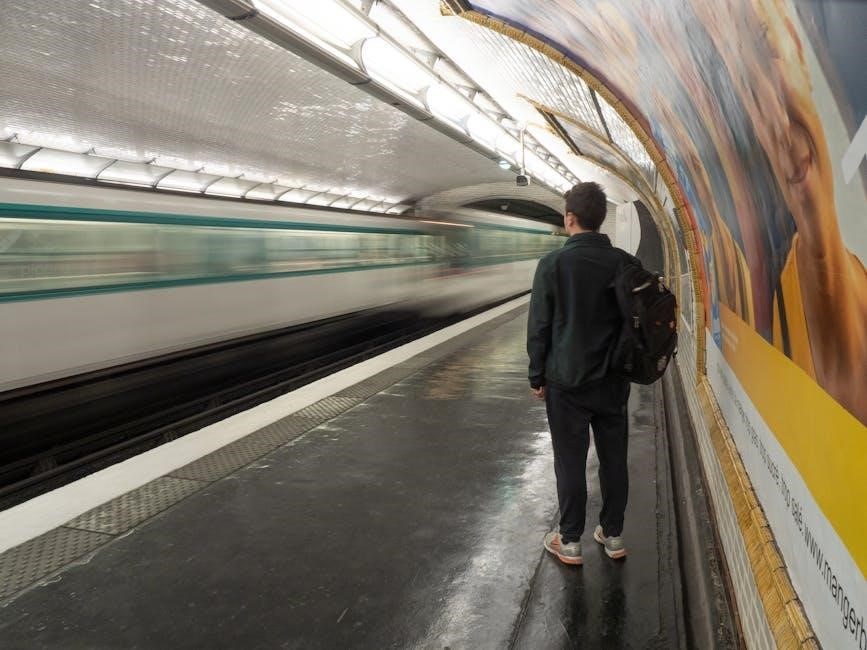How to Request a Ride

Open the app, enter your destination in the Where to? box, and confirm your pickup location. Tap Confirm to be matched with a nearby driver. Track their arrival on the map. When your driver is near, wait at the pickup location. Payment is easy—use cash, a credit card, or Uber Cash. Adjust your location by dragging the pin or typing a new address within the gray circle. Ensure a smooth ride by keeping conversations friendly and respecting the driver’s vehicle.
Scheduling a Ride in Advance
To schedule a ride in advance, open the app and tap the car-and-clock icon next to the Where to? destination box. Select your preferred date and time, then confirm your pickup and drop-off locations. The app guarantees upfront pricing, so you’ll know the exact cost regardless of future demand or surge pricing. Once scheduled, the driver will receive your request closer to the selected time. This feature is ideal for planning ahead, ensuring a ride is available when you need it most. You can book up to 30 days in advance, giving you peace of mind for early morning flights, events, or important appointments.
Adding Extra Stops During Your Journey
You can add up to two extra stops during your ride by tapping the Where to? destination box and entering additional addresses. The app adjusts the fare based on the time and distance added by these stops. To add a stop, simply type the new address or drag the pin on the map. This feature is perfect for running errands, picking up friends, or making multiple deliveries. The driver will receive the updated route, ensuring a seamless journey. Note that adding stops may increase your overall trip duration and cost. Plan ahead and use this feature wisely to make the most of your ride-sharing experience.

Safety Tips for Riders
Always verify driver and vehicle details before entering. Use in-app safety tools like emergency buttons or sharing your ETA. Ensure the driver’s info matches the app.
Ensuring Safety Before and During the Ride
Always verify the driver’s identity, vehicle, and license plate before entering the car. Use the app to track your journey in real-time. Share your ETA with trusted contacts for added security. Keep conversations friendly and avoid distractions. If uncomfortable, use the in-app emergency button or contact support. Ensure your pickup location matches the app’s suggestion. Avoid sharing personal details with drivers. Stay alert and follow your route on the map. If issues arise, report them through the app after the ride. Prioritize your safety by following these guidelines to ensure a secure and pleasant experience.
Emergency Protocols and Support Systems
Uber has implemented robust emergency protocols to ensure rider safety. In case of an emergency, use the in-app emergency button to instantly connect with local authorities. The app also shares your real-time location and trip details with emergency services. Additionally, 24/7 customer support is available through the app for any concerns. After the ride, report any issues using the in-app feedback system. Drivers are trained to handle unexpected situations, and riders can access support directly through the app. These features are designed to provide peace of mind and immediate assistance when needed. Always prioritize your safety by being aware of your surroundings and using these tools if necessary.

Understanding Ride Pricing
Ride-sharing pricing uses a dynamic model based on time, distance, and demand. Base fares, plus per-minute and per-mile rates, apply. Tolls, taxes, and fees are included, ensuring transparent costs.
Factors That Affect the Cost of a Ride
The cost of a ride is influenced by several factors, including time of day, distance traveled, and demand. Peak hours, such as rush hour or late nights, often result in higher fares due to increased demand. Additionally, the distance and duration of the trip play a significant role, as rides are typically charged per mile and per minute. Traffic and route changes can also impact the final cost. Surge pricing, which occurs during high-demand periods, can significantly increase fares. Other factors include tolls, taxes, and service fees. Base fares and minimum charges apply regardless of these variables. Understanding these elements helps riders estimate and manage their expenses effectively.
Using Price Estimators for Accurate Fare Prediction
Price estimators are essential tools for predicting ride costs accurately. Platforms like Uber and Lyft offer fare estimates based on distance, time of day, and demand. These tools consider factors such as traffic patterns, route optimization, and current pricing trends. By entering your pickup and drop-off locations, you can get an estimated fare before booking. Some apps, like RideGuru, compare prices across multiple services to help you find the best option. Using these estimators ensures transparency and helps avoid surprises. They also allow you to adjust your travel plans to save money. Regular updates and real-time data make these tools reliable for accurate fare prediction, giving you control over your expenses.
Rider Etiquette
Rider etiquette is essential for a positive experience. Be polite, keep conversations friendly, and avoid distractions. Respect the driver’s vehicle and follow app guidelines for behavior.
Behavior Expectations in the Vehicle
Respect and courtesy are key to a positive ride-sharing experience. Keep conversations friendly and avoid loud noise. Refrain from eating or drinking in the vehicle unless permitted. Always fasten your seatbelt and avoid slamming doors; Respect the driver’s personal space and belongings. Keep the vehicle clean and avoid damaging it. Be mindful of strong perfumes or odors that might disturb others. Avoid distracting the driver while they are navigating. Follow all local laws, such as not using electronic devices without a hands-free setup. By maintaining respectful behavior, you contribute to a comfortable and enjoyable ride for everyone involved.
Effective Communication with Drivers

Clear communication is essential for a smooth ride-sharing experience. Always confirm your pickup location and destination details before starting the trip; If you have specific route preferences, politely inform the driver. Keep conversations friendly and respectful, avoiding loud noise or distractions; Use the app’s messaging or calling features to communicate with your driver before or during the ride. Be clear about any special requests, such as stopping for a quick break. After the ride, provide feedback through the app to help improve future experiences for both drivers and riders. Good communication ensures mutual respect and a pleasant journey for everyone involved.

Advanced Features of Ride-Sharing Apps
Apps offer scheduling rides in advance, adding extra stops, and renting e-bikes. Price estimators provide fare predictions, ensuring transparency and convenience for all users.
Renting E-Bikes and E-Scooters Through the App
Many ride-sharing apps now offer the option to rent e-bikes and e-scooters directly through their platforms. This feature, available in select cities, provides an eco-friendly and cost-effective way to navigate short distances. Users can locate nearby e-bikes or scooters using the app’s built-in map, which displays availability and rental locations. Once a vehicle is selected, the app guides you through the unlocking process, often requiring a one-time fee or ongoing rental charges. Payment is handled seamlessly within the app, and safety tips are provided to ensure a smooth experience. This integration enhances mobility options, promoting sustainable transportation while offering convenience for urban commuters and tourists alike.
Booking Rides for Multiple Destinations
Booking rides for multiple destinations is a convenient feature offered by many ride-sharing apps. Users can add up to two extra stops during their journey by tapping the “+” icon next to the “Where to?” box. Enter each address sequentially, and the app will adjust the route accordingly. The fare will be recalculated based on the added stops, considering time and distance. This feature is ideal for running errands, dropping off items, or visiting multiple locations in one trip. Ensure the app supports this feature in your city, as availability may vary. By planning your route in advance, you can streamline your travel and save time. This option is perfect for those with complex itineraries or shared rides with friends heading in the same direction.

Tourist’s Guide to Ride-Sharing
Ride-sharing is a convenient way for tourists to explore cities worldwide. Use apps like Uber or Lyft to navigate unfamiliar areas, find popular destinations, and enjoy hassle-free travel. Features like price estimators and route planning make it easy to budget and plan your trips. Real-time updates and in-app support ensure a smooth experience for visitors. Whether you’re sightseeing or heading to local hotspots, ride-sharing apps are a reliable and affordable option for getting around.
Choosing the Right Tour or Ride Option
When selecting a ride or tour option, consider your preferences, budget, and group size. Popular destinations often offer tailored rides, such as sightseeing tours or direct routes to landmarks. Read reviews and check ratings to ensure reliability and quality. Compare prices using fare estimators to find the best value. For larger groups, opt for shared rides or book multiple vehicles. Customize your experience by filtering options like eco-friendly rides or luxury vehicles. Plan ahead by scheduling rides in advance to avoid last-minute delays. Ensure your chosen service covers your destination and offers real-time updates. By evaluating these factors, you can choose a ride option that aligns with your travel goals and enhances your exploration of new cities.
Popular Destinations and Routes
Popular destinations often include iconic landmarks, city centers, and tourist hotspots. Riders frequently request trips to airports, train stations, and major event venues. For sightseeing, cities like Paris, New York, and Tokyo offer tailored rides to attractions such as the Eiffel Tower or Central Park. Natural wonders like the Badlands are also favored for scenic explorations. Many apps suggest routes based on popularity and user reviews, helping you discover hidden gems. Plan your trip by checking app-recommended routes and peak travel times. Budget-friendly options are available for shorter distances, while long-distance rides can be booked in advance. Use fare estimators to compare costs and ensure a smooth journey to your desired location.

Environmental Impact of Ride-Sharing
Ride-sharing can reduce carbon emissions by optimizing routes and lowering empty-car miles. Many services now offer eco-friendly options, such as electric or hybrid vehicles, to minimize environmental impact.
Eco-Friendly Ride Options
Many ride-sharing platforms now offer eco-friendly alternatives to traditional rides. Users can opt for hybrid or electric vehicles, which significantly reduce carbon emissions. Some apps even allow users to rent e-bikes or e-scooters, providing a sustainable way to navigate short distances. These options not only help lower the environmental impact but also offer a cost-effective solution for eco-conscious travelers. By choosing green transportation, riders contribute to reducing air pollution and promoting cleaner energy use. Apps often highlight these eco-friendly choices, making it easier for users to select them. This shift toward sustainable mobility is a step toward creating a more environmentally responsible transportation network for future generations.
Reducing Your Carbon Footprint
To minimize your environmental impact, consider combining rides with others heading in the same direction. Many apps offer carpooling options, which reduce the number of vehicles on the road and lower emissions per person. Scheduling rides during off-peak hours can also help avoid traffic, minimizing fuel consumption. Additionally, opting for routes that avoid heavy traffic or construction can reduce idling time and unnecessary emissions. Some platforms even provide features to estimate the carbon footprint of your trip, allowing you to make more informed choices. By choosing eco-conscious options and planning your trips efficiently, you can significantly reduce your environmental impact while still reaching your destination.
